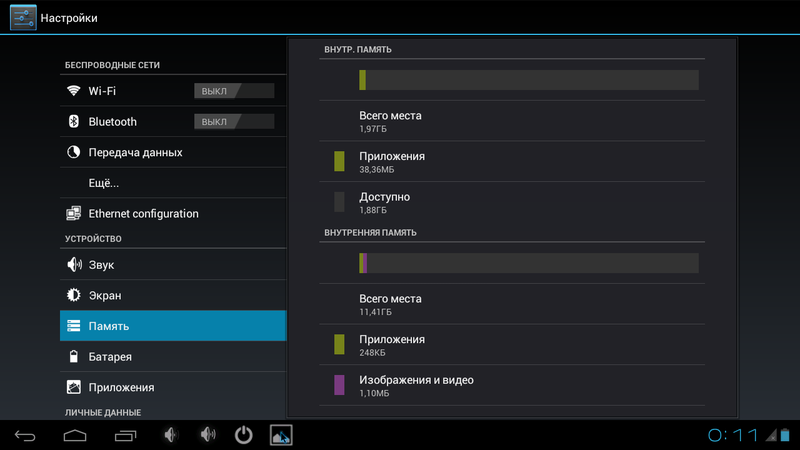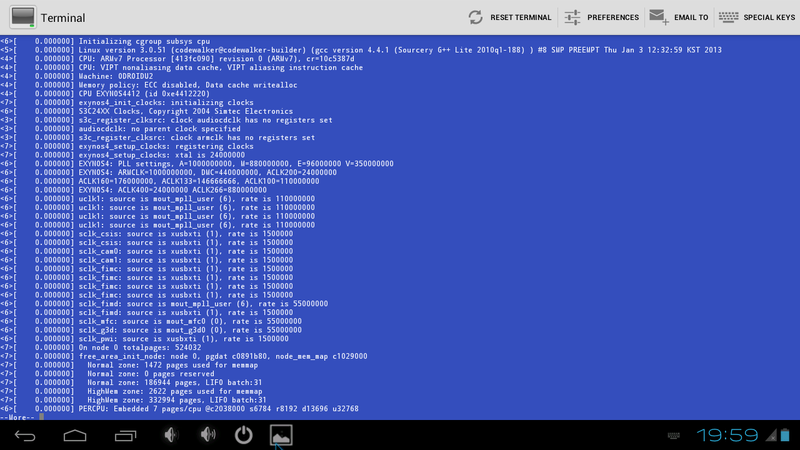Miniature boards Odroid U2 and Odroid X2
Not so long ago (~ 13.02.2012), deliveries of miniature Odroid U2 and X2 boards began, which are close in size to the Raspberry Pi, but equipped with a filling that allows them to be used as a regular computer. Without hesitation, I ordered 2 boards: Odroid U2 and Odroid X2.
A small overview of the boards under the cut.
Odroid U2 card - at a size of 48 x 52 mm (less than a credit card) The board is equipped with a Samsung Exynos 4412 Prime 1.7GHz four-core processor (ARM Cortex-A9), a Mali-400 video accelerator (Quad-core, 440MHz, support for decoding video 1080p) and 2 GB of RAM. From the connectors, there is a 3.5 mm audio output installed on a digital microphone board, 10 / 100Mbps Ethernet, 2 USB 2.0 ports, one microUSB port, UART port, microHDMI port (1920x1080), a microSD card slot and a socket for the eMMC module. Android 4.0.4 and 4.1.x, Ubuntu 12.11 (Not officially OpenSuSE 12.2, Fedora 18) are offered as software stuff. The cost of the device is 89 dollars.
')
The Odroid X2 board is about 1.5 times more than U2. Dimensions 90 x 94 mm, equipped with Samsung Exynos 4412 1.7GHz quad-core processor (ARM Cortex-A9), Mali-400 video accelerator (Quad-core, 440MHz, support for 1080p video decoding) and 2 GB of RAM. 3.5mm audio output + microphone input, 10 / 100Mbps Ethernet, 2 USB 2.0 Host ports and 4 USB ADB / Mass storage ports, one microUSB port, UART port, microHDMI port (1920x1080), 50-pin IO port with interfaces LCD / I2C / UART / SPI / ADC / GPIO, MIPI-CAM port (MIPI-CSI 2 lanes) for camera, slot for full-sized SD card and socket for eMMC module. Android 4.0.4 and 4.1.x, Ubuntu 12.11 (Not officially OpenSuSE 12.2, Fedora 18) are offered as software stuff. The cost of the device is 135 dollars.
All specifications and circuit boards are open and available on the official website . On the forum you can find a lot of useful information about installing a particular OS.
So, on February 14, 2013, I ordered a set of:
ODROID-X2 - $ 135.00
ODROID-U2 - $ 89.00
16GB eMMC Module X2 - $ 39.00
16GB eMMC Module U2 - $ 39.00
USB-UART Module Kit - 2 x $ 15.00
5V / 2A Adapter - $ 9.00
IO Board - $ 15.00
Total: $ 406.00 (Of which $ 50 for delivery)
After 2 days, the manufacturers contacted me and explained that they could only send my order on March 6. I said okay and started to wait. On March 6, we received a letter from FedEx indicating the shipment number and the tracking address. March 14, I received an order in Chelyabinsk.
Here comes a small box:

Inside that ordered:

In the picture above left to right:
1. Odroid U2 board
2. Odroid X2 board
Lower left to right:
1. The power supply, I just want to note that it has a 2 mm thick plug. I did not find one in our stores from the first raid, so it was easier to buy ready-made.
2. USB-UART Module Kit - on Odroid boards, the levels are 1.8V, and I had an adapter with 5V and 3.3V levels, I did not want to solder the new converter, so I ordered it. Drivers can be downloaded here .
3. IO Board - I / O board, built on the basis of pic18f45k50. Drivers, firmware sources, examples of use in Android and Ubuntu can be found here and here .
4. 16GB eMMC Module U2 - memory module for Odroid U2 with pre-installed Android 4.0.4
5. 16GB eMMC Module X2 - memory module for Odroid X2 with pre-installed Android 4.0.4
6. eMMC Module Reader - an adapter for connecting eMMC modules to the slot of a standard microSD card reader for subsequent uploading of firmware onto them.
7. A set of pins for USB-UART Module Kit
8. USB to microUSB cable
Separately, I want to note that the Odroid boards use a microHDMI connector, so I bought the appropriate cable in advance, the issue price is 200 p.
Also pleased with the fact that the OS can be loaded either from the eMMC module or from the microSD card, on the Odroid X2 there is a jumper to select the boot device, the Odroid U2 boot device automatically selects (priority from the eMMC).
Putting it all together, connecting the wireless keyboard and mouse, turning on the power, waiting a few seconds, and we’ll see the familiar Android screen.

The application suite is rather poor

There are no Google applications in the bundle, but there is a video player, browser, terminal — enough to get you started.
System and Memory Information:


First of all we go to the terminal, we look at dmesg (I don’t show the whole log of the download, there are too many screenshots):

And finally, we are launching a video player, trying to connect to a home computer and play some video.
I immediately wanted to try something heavier, I launched Tron in 3D HD format.
No slowdowns and glitches were noticed, the picture went smoothly and smoothly, the sound was clear, without delays and jerks. The processor power is more than enough to decode HD video, which I was very pleased about.

For now, for now, the general impressions of the 2 boards are only positive.
In the following review I will try to describe the installation of Ubuntu, work with I / O ports and other aspects.
A small overview of the boards under the cut.
Odroid U2 card - at a size of 48 x 52 mm (less than a credit card) The board is equipped with a Samsung Exynos 4412 Prime 1.7GHz four-core processor (ARM Cortex-A9), a Mali-400 video accelerator (Quad-core, 440MHz, support for decoding video 1080p) and 2 GB of RAM. From the connectors, there is a 3.5 mm audio output installed on a digital microphone board, 10 / 100Mbps Ethernet, 2 USB 2.0 ports, one microUSB port, UART port, microHDMI port (1920x1080), a microSD card slot and a socket for the eMMC module. Android 4.0.4 and 4.1.x, Ubuntu 12.11 (Not officially OpenSuSE 12.2, Fedora 18) are offered as software stuff. The cost of the device is 89 dollars.
')
The Odroid X2 board is about 1.5 times more than U2. Dimensions 90 x 94 mm, equipped with Samsung Exynos 4412 1.7GHz quad-core processor (ARM Cortex-A9), Mali-400 video accelerator (Quad-core, 440MHz, support for 1080p video decoding) and 2 GB of RAM. 3.5mm audio output + microphone input, 10 / 100Mbps Ethernet, 2 USB 2.0 Host ports and 4 USB ADB / Mass storage ports, one microUSB port, UART port, microHDMI port (1920x1080), 50-pin IO port with interfaces LCD / I2C / UART / SPI / ADC / GPIO, MIPI-CAM port (MIPI-CSI 2 lanes) for camera, slot for full-sized SD card and socket for eMMC module. Android 4.0.4 and 4.1.x, Ubuntu 12.11 (Not officially OpenSuSE 12.2, Fedora 18) are offered as software stuff. The cost of the device is 135 dollars.
All specifications and circuit boards are open and available on the official website . On the forum you can find a lot of useful information about installing a particular OS.
So, on February 14, 2013, I ordered a set of:
ODROID-X2 - $ 135.00
ODROID-U2 - $ 89.00
16GB eMMC Module X2 - $ 39.00
16GB eMMC Module U2 - $ 39.00
USB-UART Module Kit - 2 x $ 15.00
5V / 2A Adapter - $ 9.00
IO Board - $ 15.00
Total: $ 406.00 (Of which $ 50 for delivery)
After 2 days, the manufacturers contacted me and explained that they could only send my order on March 6. I said okay and started to wait. On March 6, we received a letter from FedEx indicating the shipment number and the tracking address. March 14, I received an order in Chelyabinsk.
Here comes a small box:

Inside that ordered:

In the picture above left to right:
1. Odroid U2 board
2. Odroid X2 board
Lower left to right:
1. The power supply, I just want to note that it has a 2 mm thick plug. I did not find one in our stores from the first raid, so it was easier to buy ready-made.
2. USB-UART Module Kit - on Odroid boards, the levels are 1.8V, and I had an adapter with 5V and 3.3V levels, I did not want to solder the new converter, so I ordered it. Drivers can be downloaded here .
3. IO Board - I / O board, built on the basis of pic18f45k50. Drivers, firmware sources, examples of use in Android and Ubuntu can be found here and here .
4. 16GB eMMC Module U2 - memory module for Odroid U2 with pre-installed Android 4.0.4
5. 16GB eMMC Module X2 - memory module for Odroid X2 with pre-installed Android 4.0.4
6. eMMC Module Reader - an adapter for connecting eMMC modules to the slot of a standard microSD card reader for subsequent uploading of firmware onto them.
7. A set of pins for USB-UART Module Kit
8. USB to microUSB cable
Separately, I want to note that the Odroid boards use a microHDMI connector, so I bought the appropriate cable in advance, the issue price is 200 p.
Also pleased with the fact that the OS can be loaded either from the eMMC module or from the microSD card, on the Odroid X2 there is a jumper to select the boot device, the Odroid U2 boot device automatically selects (priority from the eMMC).
Putting it all together, connecting the wireless keyboard and mouse, turning on the power, waiting a few seconds, and we’ll see the familiar Android screen.

The application suite is rather poor

There are no Google applications in the bundle, but there is a video player, browser, terminal — enough to get you started.
System and Memory Information:


First of all we go to the terminal, we look at dmesg (I don’t show the whole log of the download, there are too many screenshots):

And finally, we are launching a video player, trying to connect to a home computer and play some video.
I immediately wanted to try something heavier, I launched Tron in 3D HD format.
No slowdowns and glitches were noticed, the picture went smoothly and smoothly, the sound was clear, without delays and jerks. The processor power is more than enough to decode HD video, which I was very pleased about.

For now, for now, the general impressions of the 2 boards are only positive.
In the following review I will try to describe the installation of Ubuntu, work with I / O ports and other aspects.
Source: https://habr.com/ru/post/172895/
All Articles